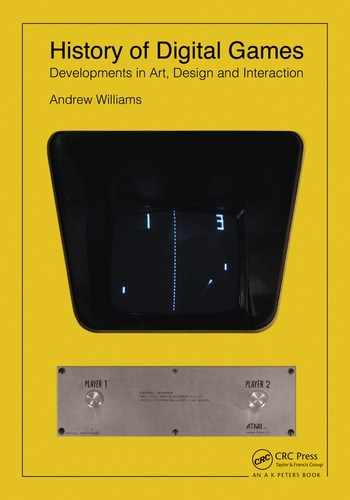Contents
CHAPTER 1 — Mechanical and Electromechanical Arcade Games (1870–1979)
The Beginnings of Coin-Operated Amusement
Automata and Coin-Op Working Models
Coin-Op Viewers at the Turn of the Century
A Gathering of Games and Amusements at the Penny Arcade
Sport-Based Games and the Roots of Digital Game Genres
A New Emphasis on Art and Design
Postwar Mechanical and Electromechanical Game Design
Driving and Racing Games after World War II
Missile-Launching Games in Japan and the United States
The Sunset of Electromechanical Games
CHAPTER 2 — Games as Experiments (1912–1977)
Electronic Computers and Games
Early Games in Research and Scientific Demonstration
Chess and Artificial Intelligence
Turing’s Imitation Game and Artificial Intelligence
Tennis for Two and the Beginning of Entertainment Applications for Computer Games
The Spread and Modification of Spacewar!
Programmed Logic for Automated Teaching Operations and Multiplayer Games
Adapting Dungeons & Dragons to PLATO
CHAPTER 3 — Early Commercialized Digital Games (1971–1977)
New Technology in the Consumer Market
Approaches to Commercialized Digital Games
The Magnavox Odyssey and Divided Game Space
Pong and Variations on Ball and Paddle Game Design
Adapting Electromechanical Games to the Digital Arcade
Racing Games in the Early Digital Arcade
Early Variants of Maze and Shooting Games
Dedicated Consoles in the Home and Signs of Trouble
CHAPTER 4 — The Golden Age Arcade (1978–1984)
Tendencies and New Concepts in the Golden Age
Shooting and Shoot ’em Ups in the Golden Age
Other Directions in Shooter Design, Input, and Theme
Stronger Characters and Narrative in Arcade Games
Laserdiscs, Narrative, and Gameplay
Eclectic Approaches to Arcade Game Design
The End of the Golden Age Arcade
CHAPTER 5 — Cartridges and Home Consoles (1976–1984)
The Second Generation of Home Consoles
Competition in the Home Market
The Emergence of Third-Party Developers
Mattel and Coleco Enter the Console Market
Adding Content to Home Console Games
Altering Time in Home Console Games
Adventure and Exploration in Console Games
Resource Management Games on Home Consoles
The North American Console Crash
CHAPTER 6 — Home Computers (1977–1995)
Computer Games of the Late 1970s and Early 1980s
From Text to Graphic Adventure Games
Early Computer Role-Playing Games
Flight and Vehicle Simulations on Computers
Visuals and Action-Adventure Games for Computers
The Mouse and Computer Games of the Later 1980s and 1990s
Developing the Point-and-Click Adventure
Management and Strategy Games in the Late 1980s and Early 1990s
Synthesis and Development of the RTS Game
CHAPTER 7 — Japan, 2D Game Design and the Rebirth of Consoles (1983–1995)
Japanese Games and Game Companies in the Early 1980s
2D Game Design Trends after the Golden Age Arcade
Side-Scrolling Action and the Beat ’em Up
The Head-to-Head Fighting Game
Western Responses to the Head-to-Head Fighting Game
Japanese Companies Transition to the Home
Stabilizing and Controlling the Console Market
Establishing Nintendo’s Franchises
Computer Games and the JRPG on the Famicom/NES
16-Bit Consoles, Marketing, and Game Design
New Platformers for New Consoles and Intensified Competition
CHAPTER 8 — Early 3D and the Multimedia Boom (1989–1996)
Two Paths to Realism: Multimedia Imagery and Real-Time 3D
Puzzle Games in the Era of Multimedia
Real-Time 3D and Spatial Realism
Early Commercialized Virtual Reality
Simulators in Arcades Spawn a 3D Revolution
Adapting Home Consoles to a 3D Context
Combining 2D Images with Real-Time 3D in PC Games
The Triumph of Real-Time 3D in Games
CHAPTER 9 — Contemporary Game Design (1996–Present)
New Hardware for Real-Time 3D Gaming
3D Game Design in the Late 1990s
Platforming and Adventure Games in Full 3D
Hybrid First-Person Shooter/Role-Playing Games at the Turn of the Millennium
Looking Glass Studios and Its Offshoots
Cinematic Perspectives at the Turn of the Millennium
Games and Game Design in the New Millennium
New Consoles and the Maturing of Games in the 2000s
The Proliferation of Open World Gameplay
Reducing Load Times on Consoles
The Emergence of Casual and Mobile Games
Digital Distribution in the 2000s
Casual Games and Digital Distribution
Game Visuals and Gameplay Aesthetics in the 2000s and Beyond
Film-Like Gameplay in the 2000s
Criticism and Backlash against the Industry
CHAPTER 10 — Independent Games (1997–Present)
The Scratchware Manifesto and Dimensions of “Indie”
The Early Independent Game Scene
Flash and Struggles for Legitimacy
Japan’s Doujin Soft and Freeware Scene
Freeware Experiments with Games and Art
The Mainstream Breakout of Independent Games
Console Manufacturers Pursue Independent Developers
